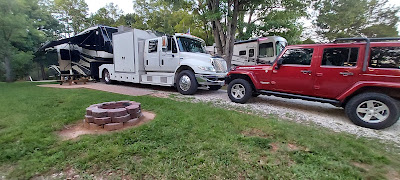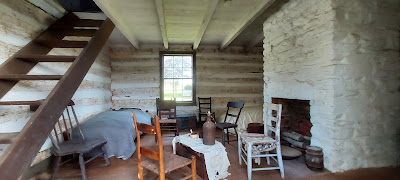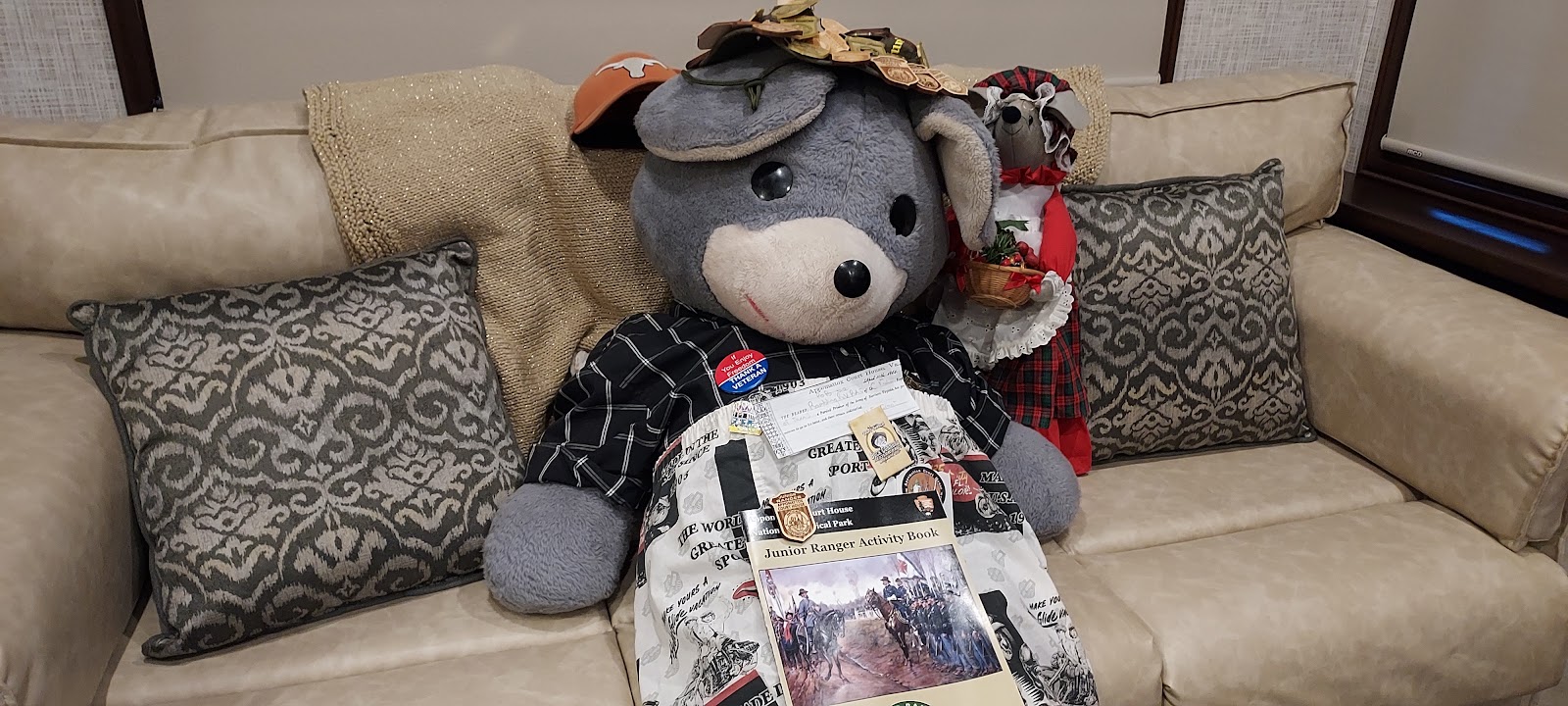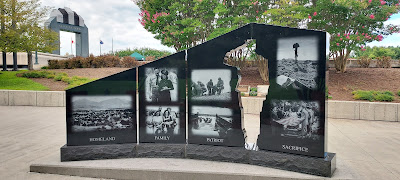We had a relaxed 3.5-hour drive along back roads
to Pope Farms, our overnight Harvest Hosts in Knightdale, North Carolina. This is a three-generation family farm that
sells quality meats, dairy, syrup, and honey.
The Popes even raise their own corn to feed their cows and pigs! I met their new baby donkey and their family
dog. We were greeted warmly by Mr. Pope. He assured us we could easily maneuver the long, winding road through a wooded area to get to the RV parking area, and I am happy to say we encountered no problems. The
parking area is lovely, with some shade along a fully-stocked fishing pond in
which guests are welcome to toss their lines. I
will warn you that it can be a little noisy on the farm with dump trucks
entering/exiting the property and the highway nearby, but we didn't mind.
 |
We were a bit skeptical at first, but we had no problem maneuvering the tight spots to arrive at the RV parking area.
|
 |
| The RV parking area overlooks this fully-stocked pond (crappies/bass/trout) and Mr. Pope invites fishing enthusiasts to cast their lines. |
The next morning we had an easy 1.5-hour drive to Hidden
Haven in Smithfield, North Carolina. Hidden Haven is a newer (2020) 160-site
RV park with large sites and easy access.
There is no office for check-in, but management was responsive to our
text inquiries. The Park advertises
extended stays, which is how most of its guests would be classified. If you have an older rig or a pop-up camper,
management excludes you from staying here.
At $50/night, it has showers, an outdoor ATM, and a playground for kids,
though it is located near quite a bit of construction debris. The Park has no laundry facility yet, but it
does have free WI-FI. Ironically, our
Verizon cell service worked great here (one of the only places with
excellent coverage among all our travels).
Truthfully, my family was not overly impressed, though I will admit, the
Park is still a work-in-progress. But it
is conveniently located just 20 minutes outside our next Civil War
destination: Bentonville Battlefield.
 |
| Hidden Haven does offer large sites with easy access. |
 |
| Not sure this Rambling RV Rat would let my offspring play here with all the construction debris nearby. |
The Battle of Bentonville has the distinction of being the
largest Civil War battle within North Carolina.
It also represents the last major Confederate offensive of the Civil War. Here’s a Rambling RV Rat abridged version of the
rest of the story:
During November and December 1864, Union General William
Sherman created a path of destruction from Atlanta to
Savannah, Georgia. Known as his “March
to the Sea”, his “scorched-earth” policy decimated city after city. He depleted the South’s resources and
demoralized the citizens of the Confederate State of Georgia. Sherman then set sights on the
Carolinas. Success was his again, when Fort Fisher (the
last Confederate fort), located in Wilmington, North Carolina, fell into
Union hands in January 1865.
In a desperate attempt to stop further Union advancements,
Confederate President Jefferson Davis called General Joseph Johnston out of
“retirement”. (In reality, the “retirement” was forced upon Johnston. You see, Davis canned him for not engaging
the enemy before Sherman reached Atlanta).
Confederate General Johnston learned of Union General
Sherman’s goal to reach Goldsboro, North Carolina, to resupply his troops at this junction of 2 railroads. But Sherman's plan was foiled when General Johnston attacked Sherman’s Union
troops on March 19, 1865, at Morris Farm in Bentonville, North Carolina. Things went well initially for the Confederates. But, by day’s end the
Confederates gained no ground, so it was considered a tactical draw. March 20, 1865, brought much less warfare,
but significant maneuvering with Union reinforcements arriving. This changed the Confederate tactic from offense to defense. On March 21, 1865, the focal point of battle
was Mill Bridge. The Confederates were
successful in maintaining control over the bridge, which then became their
retreat route to Smithfield, North Carolina.
Learning that General Robert E. Lee laid down arms at Appomattox Court House on April 9, 1865, General Johnston followed suit on April 26, 1865, in Durham, North Carolina. His action represented the largest troop surrender (90,000 soldiers) of the entire Civil War.
We hiked the Morris Farm Trail and Cole Plantation Long Loop Trail to immerse ourselves into the Civil War battle scene of yesteryear. But as we hiked to the intersection of the Mountains-to-Sea Trail (a nearly 1,200-mile trail between the Great Smoky Mountains and the Outer Banks), we encountered a battle of our own—with mosquitoes! We were able to repel their attacks initially, but then they outflanked us. We fought fervently, but the trenches along the trail, filled with standing water from recent rain, harbored enemy reinforcements. We had no choice but to retreat.


 |
| The site of Morris Farm, now cotton fields. |
t |
A close-up of a cotton plant.
|
 |
| Scenes from... |
 |
| ...the hiking trails. |
 |
| Harper House, built circa 1855, was used as a field hospital. That huge tree in the center of the photo dates to the days of the Battle of Bentonville. If only that tree could describe what it witnessed! |
 |
| The interior of Harper House reflects its use as a field hospital. |
 |
| No whiskey to chug and no bullet to bite among these hospital supplies for amputations. |
 |
| You can still see blood stains on the original floors! |
 |
| The graveyard of the Flowers family is near the Harper House. |
 |
| You are looking at the State of North Carolina's newest Junior Historian! |
The following morning, we hit the road. We were back in territory where we could
legally tow my Rambling RV Rat Pack Rubicon, so Mom and Dad shared Big Boomer
driving duty. Our destination was State
Line Movie Time Drive-In Theater in Tabor City, North Carolina, a boondocking
site (about 30 minutes from Myrtle Beach, South Carolina) that we booked
initially through Hip Camp. However, due
to a dispute between Hip Camp and State Line, their relationship was terminated. Consequently, Hip Camp cancelled our reservation and refunded us our money. State Line graciously proposed to host us
anyway, and we accepted the hospitable offer.
Now the host is certainly friendly and accommodating, but
she totally misrepresents her property.
Based on its name and her website/Facebook pages at the time, we
expected this to be like the Skyview Drive-In we stayed at on Route 66 in
Litchfield, Illinois. But the only
similarity is that she has a screen. Though
she charges to enter the outdoor theater, she offerd no first-run
movies. When Mom asked what was playing,
the host said, “whatever you want to watch”—we could make a film selection from
her DVD library. (I don’t know how
you feel, but this Rambling RV Rat ain’t wasting cheese money to watch
something that I can get for free with my Amazon prime subscription, sitting in
my comfy recliner, and with no mosquitoes swarming!)
We asked where to park the RV. The host told us to come in through the gate
and park anywhere in the field. The
problem was that we couldn’t fit through the width of the gate! She then offered an alternate entrance, but
we would need to go across a narrow wooden bridge flanked by two huge
trees! Again, there was no way we could
fit, nor could the bridge handle the weight of our set-up! Fortuitously, she has a side property that is
a big open field, dry enough to handle our weight, and no gates or obstructions
to entry. Bingo, we had a winner!
Now, it was time to pay.
The host asked for $50/night in cash.
I nearly choked on my cheddar cheese! The rate was $43.50/night when we booked through Hip Camp via a credit card! Mom negotiated her down to $45/night in cash—which is
still steep for boondocking/no amenities whatsoever. But it was a steal compared to the $125/night
it would cost for a back-in site at the North Myrtle Beach RV Park and Marina,
at which we stayed on our previous visits (2019 cost $70 night; 2021 $85
night). Anyway, we were out of the rig most of the day, returning in the
evening only to sleep.
 |
| Though not where State Line typically parks its RV guests, we were lucky the host owned this side property. |
 |
| Our boondocking spot at State Line sure offered an awesome sunset. |
We took a tour of the Myrtle Beach area, seeing what had changed since our prior visits (you now pay for beach access in addition to parking!). But the real purpose of staying in this area was to visit with long-time friends Kevin/Ellen and Denise/Dean. Both sets of friends relocated to this area from New Jersey. What a blast we had reconnecting, reminiscing, and, of course, feasting at some wonderful local restaurants!
We moved on to Cane Creek Park in Waxhaw, North
Carolina. We have stayed on Site 37 here
3 times previously, and always had a positive experience. Operated by Union County, this lovely lake-side
park is perfect for affordable family fun.
It offers full-hook-up sites for $37/night, hiking trails, camp store,
playground, and beach. And it is located
right across the border from the residences of more cherished New Jersey
friends, Jeffrey and Sandy/Donny, with whom we share the love of
motorcycling. Jeffrey hosted a wonderful
get-together for us all at his tiki bar!
 |
| The lake at Cane Creek Park in Waxhaw, North Carolina. |
 |
| My parents posing with Dad's trike, Maximus. |
Well, I am tuckered out, so I'll sign off now. But I’ll talk to you again soon!




























































